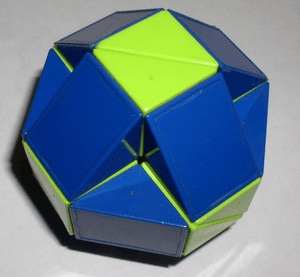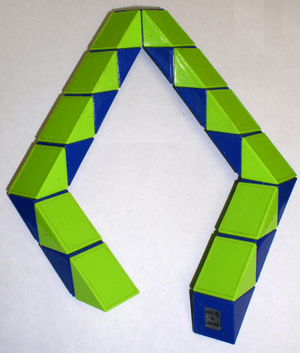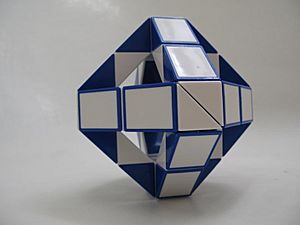Rubik's Snake facts for kids
The Rubik's Snake is a fun toy made of 24 triangle-shaped pieces. These pieces are connected by special bolts that let them twist around. You can twist the snake into many different shapes, like animals, objects, or cool geometric forms! When you first get it, it often comes twisted into a unique ball shape.
This clever toy was invented by Ernő Rubik. He is also famous for creating the Rubik's Cube. The Rubik's Snake came out in 1981, when the Rubik's Cube was super popular. Ernő Rubik said that the snake isn't a puzzle to solve. Instead, it offers endless ways to create new shapes. He believed it was a tool to explore shapes in space.
How the Rubik's Snake Is Built
The Rubik's Snake has 24 triangle pieces, called prisms. They are lined up one after another, with their directions switching. Each prism can turn in 4 different ways, moving 90 degrees each time. Usually, the prisms have two different colors that switch back and forth.
How to Twist Your Rubik's Snake
You can follow steps to make specific shapes with your Rubik's Snake. Imagine your snake is a straight bar. Some pieces point up, and some point down. The flat sides face up and down. The triangle sides face you.
We can number the 12 pieces that point downwards from 1 to 12, starting from the left. Each of these pieces has a left (L) and a right (R) side that connects to another piece.
The piece next to it can be twisted into 4 positions. We number these positions 0, 1, 2, and 3. Position 0 is the starting straight position.
- Position 1: Twist the next piece towards you.
- Position 2: Twist the next piece 90 degrees.
- Position 3: Twist the next piece away from you.
So, a twisting instruction tells you:
- Which downward-facing piece to use (1 to 12).
- Which side (L or R) of that piece to twist.
- Which position (1, 2, or 3) to twist it to.
Here are some examples of shapes you can make:
| Example Shape | Twisting Instructions |
|---|---|
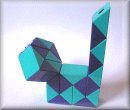 |
Cat
9R2-9L2-8L2-7R2-6R2-6L2-5L3-4L2-3R2-2R2-2L2 |
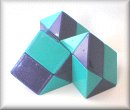 |
Three Peaks
6R1-6L3-5R2-5L3-4R2-4L1-1R1-3L3-3R2-7L2-7R3-8L1-8R2-9L1-9R2-10L3-12R3-11L1-10R2 |
How Many Shapes Can It Make?
The Rubik's Snake has 23 places where it can twist. Each twist point has 4 possible positions. This means there are a huge number of possible shapes! Mathematically, it could be up to 4 to the power of 23, which is over 70 trillion shapes!
However, not all of these shapes are actually possible. Some would make the pieces crash into each other. Scientists have figured out that the real number of unique shapes is around 6.7 trillion. That's still a massive number of ways to twist your snake!


